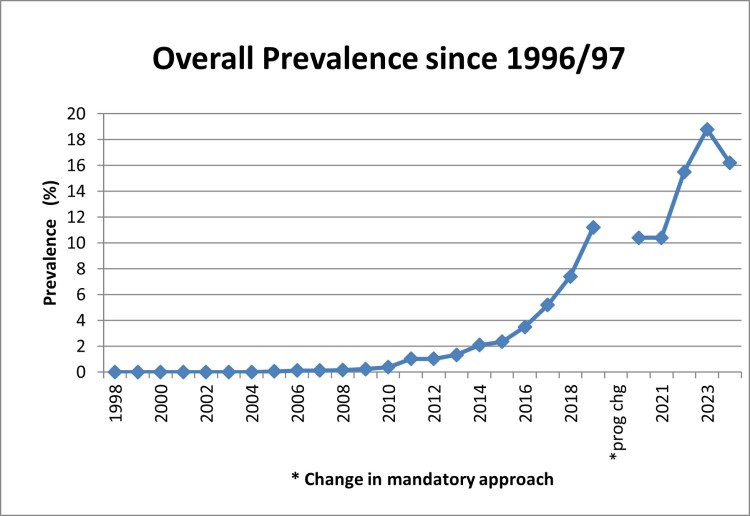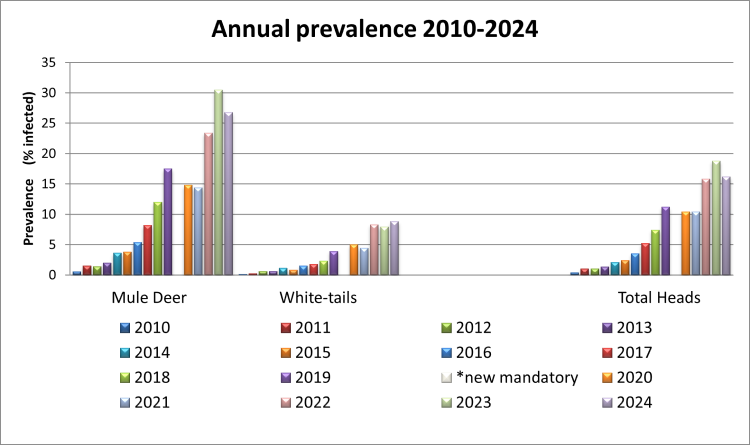Non-urgent government operations are closed December 24 to January 1, reopening January 2. View available services during this period.
CWD updates
CWD surveillance update: October 10, 2025
Fall hunting seasons are underway again and we rely on public support for Alberta’s year-round surveillance of chronic wasting disease (CWD). Seasonal staff are setting up freezers where hunters can drop off heads of harvested cervids, primarily mule deer and whitetails. All freezers will be in place prior to November 1. In mid December staff will remove, clean, and store the freezers.
An updated map of the 2025 freezer locations is provided at Chronic Wasting Disease – Information for Hunters. Information about WMUs designated for mandatory head submission for 2025 also is provided in the 2025 Alberta Guide to Hunting Regulations.
While CWD occurs in deer throughout central and eastern Alberta, we continue to focus surveillance along parts of the border with Saskatchewan and along the northern and western edge of the disease distribution. Please ensure that any heads submitted for CWD testing have the requested information about the hunter AND the harvested animal. In other words, remember to fill out BOTH sides of the pre-printed CWD green labels. And remember to keep your portion of the green label - it has the unique CWD number associated with each head that you submit for testing. The email with your results will include the CWD # associated with that animal.
The success of the CWD surveillance program remains fully grounded in the support and efforts of hunters, harvesters, guides, and landowners. Your continued support is gratefully acknowledged.
- More information about the program is provided below, and specific details updated annually for hunters is on CWD information for hunters.
Alberta’s ongoing program to monitor the occurrence and spread of CWD supports game management and deer harvest decisions, particularly in regards to mule deer. The program continues to adapt to changing patterns in the occurrence and spread of the disease in wild deer. The province relies heavily on hunter-harvested deer heads, or specific tissues thereof, for testing.
- Previous results are available at CWD History in Alberta.
CWD management program goals
The surveillance program has 2 primary goals:
- Continue to document long-term effects of CWD in select deer populations along the Alberta-Saskatchewan border where it has occurred since the early 2000s (8 mandatory WMUs).
- Track the westward and northern spread along the leading edges of the known distribution of CWD in wild deer (a series of designated WMUs of interest).
As such, the areas where hunters are asked to submit heads reflect these 2 primary game management goals.
Deer head submission locations and contacts
The program continues to deploy 24-hour freezers within these targeted areas during primary rifle seasons, but cannot provide them elsewhere in the province.
A map of the 2024-25 surveillance areas with a list of specific freezer locations is provided at CWD information for hunters
- Freezers generally are present mid October to mid December
The Alberta government continues to test any head from any cervid legally harvested in Alberta. However, opportunities for submitting heads outside the target areas are extremely limited. Some local Fish and Wildlife or Environment and Protected Areas offices may no longer accept deer heads. Phone ahead before you visit an office.
- Fish and Wildlife area office contacts
- Office contact information may also be found on page 14 of 2025 Alberta Guide to Hunting Regulations
As in previous years during the rifle seasons, 24-hour freezers are placed strategically throughout the surveillance areas to make it easier for hunters to drop off heads for testing. Instructions and materials are provided at each freezer.
What we need you to do
- Fill out both sides of the green CWD labels with all the requested information.
- Keep the bottom portion of the label for your records as it has the CWD number associated with the head you submitted.
- Use one label for each head you submit but DO NOT take extra labels from the freezers. Leave them for other hunters to use.
Note: the head drop-off freezers are only available approximately mid-October to mid-December.
CWD testing schedule and results
All hunters who submit a head receive their test results directly in an email using the email address in their AlbertaRELM account. Hunters without an email address in their account are phoned only if the animal is positive for CWD.
The total number of CWD cases detected in wild deer, elk, and moose in Alberta since September 2005 is 6,635.
Free CWD replacement licences were discontinued in 2017.
- These licences originally were intended to encourage hunters to return to areas of Alberta where CWD was first detected, but hunter interest and harvest in the CWD area remained high so the free replacement licence program ended.
- With increased prevalence and distribution of CWD, replacement licences created a disproportionate harvest opportunity and advantage over hunters who had to build priority points to access a licence, particularly for antlered mule deer
- CWD occurs in localized pockets, so hunters harvesting from the same small population each year were more likely to harvest an infected deer and gained access to annual free replacement licences.
As the number of CWD cases increased over time, the number of replacement licences:
- became disproportionate to the number of licences available to individuals who applied for draws
- limited the diversity of opportunity for broader populations of hunters, particularly those who wished to hunt mule deer males
CWD and human health
While there are no known cases of CWD in humans, health authorities recommend precautions.
- Additional information is available at CWD and Public Health.
Thank you, hunters, guides and landowners
Alberta CWD hunter surveillance began in 1998 and has one of the best continuous datasets documenting the occurrence and patterns of CWD in wild cervids, specifically in prairie and parkland ecosystems. The continued support of hunters, guides and landowners is the basis for the strength of our surveillance data.
The success of the CWD surveillance program relies heavily on participation by hunters, guides, and landowners to ensure a successful harvest that provides heads to be tested. We heartily acknowledge and thank all those who helped make the program so successful and look forward to your continued support.
Patterns of CWD in Alberta
There are significant overall patterns of disease occurrence in Alberta. CWD continues to occur primarily in mule deer in comparison to white-tailed deer despite testing large numbers of both species. Similarly males are more likely to be infected than females.


Analyses of previous data determined the weighted CWD occurrence in Alberta is:
- Mule Deer: male 1.00 female 0.4
- White-tailed Deer: male 0.3 female 0.1
Thus male mule deer are the most likely, and female white-tailed deer the least likely to be infected with CWD.
The geographic distribution of CWD is clustered in some WMUs but continues to expand westward.
- Chronic Wasting Disease in Alberta by wildlife management unit reports
- Chronic Wasting Disease in deer in Alberta:
In conjunction with the University of Alberta, we used Alberta’s surveillance data to model the risk of CWD in male mule deer.
We looked at 3 periods:
- a 7-year period since the first case (2005-12)
- more recent data (2013-17)
- the cumulative risk over all years showing the progressive increase of risk from 2005 to 2017
View the CWD risk report at: Chronic wasting disease change in risk over time in male mule deer – 2005 to 2017.
The following map tracks the year when CWD was first detected in select Wildlife Management Units (WMUs): Chronic wasting disease in Alberta by year of first detection.
The prevalence (% infected) of CWD in male mule deer continues to increase in Alberta. For details, see: Prevalence (% infected) of CWD in male mule deer.
The finding of CWD in a moose near the South Saskatchewan River valley in 2012 was the first such case identified in Canada: CWD in Moose in Alberta.
Specific information about the CWD hunter surveillance program is provided at CWD information for hunters
- CWD surveillance is focused on the Alberta-Saskatchewan border and along the western and northern edge of the area where CWD is known to occur. However, hunter-killed deer (and elk) are accepted from anywhere in the province (as in all previous years)
Surveillance results
2024 final fall CWD surveillance results
In 2024-25, we tested 2,963 wild cervids. Overall, CWD was detected in 472 wild deer, elk and moose (16.2% overall: 353 mule deer (263 males, 90 females), 103 whitetails (94 males, 9 females), 9 elk (4 males, 5 females), 7 moose (4 males, 3 females).
CWD was found in:
- 26.8% of 1,318 mule deer
- 8.8% of 1,166 white-tailed deer
- 3.9% of 232 elk (primarily from CFB Suffield)
- 3.8% of 186 moose (primarily from CFB Wainwright)
In 2,480 deer for which gender/sex was reported, CWD was detected in:
- 32.5% of 809 male mule deer
- 17.8% of 506 female mule deer
- 11.0% of 856 male whitetails
- 2.9% of 309 female whitetails
CWD was detected in five Wildlife Management Units where it was not previously documented along the western edge of the disease occurrence in the province (WMU 221, 247, 306, 505, 508). Also, a higher proportion of deer tested in 2024/25 were harvested along the western edge of the known CWD distribution in Alberta. As a result, the overall prevalence values are lower than in 2023/24. However, within individual WMUs, prevalence continues to increase.
- Learn more Alberta's CWD surveillance and response
- For past CWD surveillance results and a timeline of CWD in Alberta, see CWD history in Alberta
Maps and statistics
- Chronic Wasting Disease in wild cervids in Alberta – Maps
- Chronic Wasting Disease in wild cervids in Alberta, 2019 to current – Statistics
- Chronic Wasting Disease in wild cervids in Alberta, 2005 to 2018 – Statistics
News
- Nineteen new cases of chronic wasting disease in wild deer (April 1, 2011)
- Eight new cases of chronic wasting disease detected in wild deer (March 20, 2009)
- Opportunities abound for Alberta hunters in 2007 guide/Alberta continues program to manage chronic wasting disease (July 16, 2007)
- Testing completed for chronic wasting disease winter program (May 8, 2007)
- Expanded chronic wasting disease testing discovers three more cases (April 5, 2007)
- Alberta takes action on chronic wasting disease in wild deer (February 22, 2007)
- Three more cases of chronic wasting disease found in wild deer (December 21, 2006)
- Alberta hunters asked to assist with CWD control efforts (September 15, 2006)
- Winter efforts to control CWD in wild deer in Alberta wrap up (April 18, 2006)
- Winter tests find one more case of CWD in wild deer in Alberta (March 3, 2006)
- Four more cases of CWD found in wild deer in Alberta (February 17, 2006)
- First case of CWD found in wild deer killed by hunter in Alberta (December 9, 2005)
- No chronic wasting disease found in latest culled deer (November 4, 2005)
- Chronic wasting disease found in two more wild deer in Alberta (October 3, 2005)
- Chronic wasting disease found in a wild deer in Alberta (September 2, 2005)